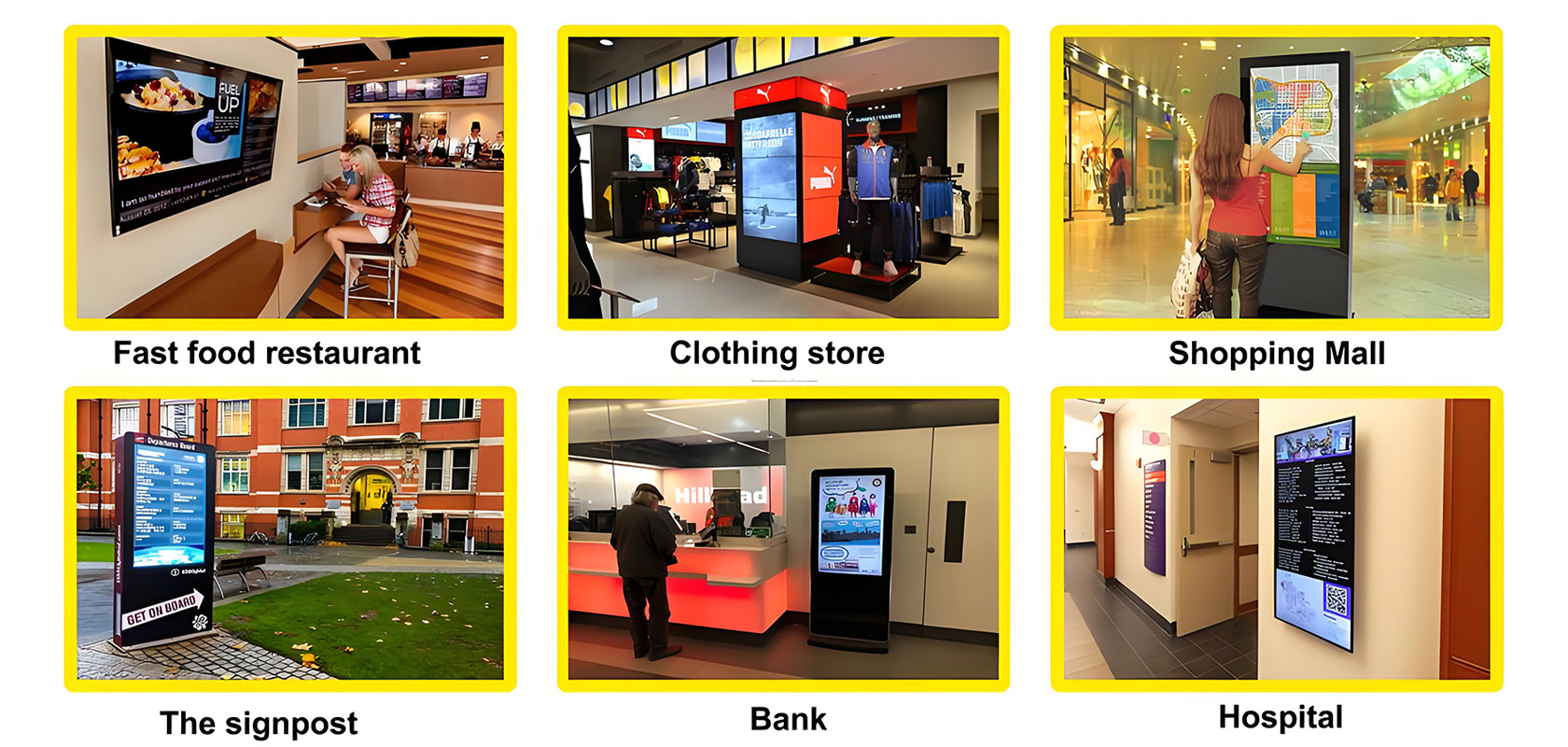Digital Signage for Education: Enhancing Learning Environments
Digital Signage for Education: Enhancing Learning Environments.In the era of digital transformation, educational institutions are continuously seeking innovative ways to enhance learning experiences and create more engaging environments for students. One technology that has gained significant momentum in this pursuit is digital signage. This article explores the concept of digital signage in education, its benefits, implementation strategies, and the transformative impact it can have on learning environments.

Introduction to Digital Signage
Digital signage refers to the use of electronic displays, such as LCD, LED, or projection screens, to present information, advertisements, or other content in a dynamic and interactive manner. Unlike traditional static signage, digital signs can be updated remotely and instantly, allowing for the display of real-time information and interactive content. This flexibility makes digital signage a powerful tool for a variety of settings, including retail, corporate, and, increasingly, educational institutions.
The Role of Digital Signage in Education
In educational settings, digital signage serves as a versatile platform for communicating information, engaging students, and enhancing the overall learning experience. It can be used in classrooms, libraries, hallways, cafeterias, and even outdoors to deliver a wide range of content, from announcements and schedules to interactive lessons and educational games.
Enhancing Communication
One of the primary benefits of digital signage in education is its ability to streamline communication. Schools can use digital signs to broadcast important announcements, updates, and schedules in real-time, ensuring that students and staff are always informed. This reduces the need for printed materials, which can be easily lost or overlooked, and allows for more efficient dissemination of information.
Interactive Learning
Digital signage also offers opportunities for interactive learning. Interactive displays can be used to create engaging educational experiences that capture students' attention and encourage participation. For example, touchscreens can be used for interactive quizzes, games, and simulations that make learning fun and memorable.
Personalized Learning
Another advantage of digital signage is its potential for personalization. By leveraging data analytics and student information systems, schools can tailor the content displayed on digital signs to individual students' needs and interests. This can help create a more personalized learning experience and address the diverse learning styles and abilities of students.
Benefits of Digital Signage in Education
The implementation of digital signage in educational institutions can yield numerous benefits, both for students and for the institution itself.
Improved Student Engagement
Digital signage can significantly enhance student engagement by providing visually appealing and interactive content that captures their attention. This can lead to increased motivation and interest in learning, as well as improved retention of information.
Enhanced Learning Outcomes
By incorporating interactive and multimedia elements, digital signage can help students better understand complex concepts and retain information more effectively. This can result in improved academic performance and higher levels of achievement.
Cost Savings
Digital signage can also lead to cost savings for educational institutions. By replacing printed materials with digital content, schools can reduce printing and distribution costs. Additionally, the ability to update content remotely eliminates the need for manual updates, saving time and resources.
Increased Efficiency
Digital signage streamlines communication processes, allowing for more efficient dissemination of information. This can free up staff time and resources, enabling educators to focus on teaching and supporting students.
Implementation Strategies
Successfully implementing digital signage in educational institutions requires careful planning and consideration. The following strategies can help ensure a smooth and effective implementation process.
Assess Needs and Goals
Before implementing digital signage, it is essential to assess the specific needs and goals of the institution. This includes identifying the types of content that will be displayed, the target audience, and the desired outcomes. By understanding these factors, schools can tailor their digital signage strategy to meet their unique needs.
Choose the Right Hardware and Software
Selecting the appropriate hardware and software is crucial for the success of a digital signage implementation. Schools should consider factors such as display size, resolution, and durability, as well as the ease of use and functionality of the software. It is also important to choose a system that is scalable and can grow with the institution's needs.
Develop a Content Strategy
A well-defined content strategy is essential for maximizing the impact of digital signage. This includes determining the types of content that will be displayed, the frequency of updates, and the overall design and layout. Schools should also consider the use of multimedia elements, such as videos, animations, and interactive features, to engage students and enhance learning.
Train Staff and Students
To ensure the successful adoption of digital signage, it is important to provide training for staff and students. This includes training on how to use the system, create and update content, and troubleshoot common issues. By empowering staff and students to use digital signage effectively, schools can maximize its potential and ensure a positive user experience.
Monitor and Evaluate
Regular monitoring and evaluation are essential for assessing the effectiveness of digital signage and identifying areas for improvement. Schools should track key metrics, such as student engagement, academic performance, and cost savings, to measure the impact of their digital signage implementation. This information can be used to refine the content strategy and make adjustments as needed.
Case Studies: Digital Signage in Action
To illustrate the transformative impact of digital signage in education, the following case studies highlight successful implementations in educational institutions.
Case Study 1: University of XYZ
The University of XYZ implemented digital signage throughout its campus to improve communication and engagement with students. The university used digital signs to display event schedules, class reminders, and campus news, as well as interactive maps and wayfinding information. The result was a significant increase in student engagement and satisfaction, as well as improved communication between the university and its students.
Case Study 2: ABC High School
ABC High School incorporated interactive digital signage in its classrooms to enhance learning experiences. Teachers used touchscreens to display interactive lessons, quizzes, and educational games, which captured students' attention and increased their motivation to learn. The school also used digital signage to display real-time feedback and progress reports, helping students track their learning and identify areas for improvement.
Challenges and Considerations
While digital signage offers numerous benefits for educational institutions, there are also challenges and considerations that must be addressed.
Cost and Budgeting
The initial cost of implementing digital signage can be a significant investment for some schools. It is important to carefully budget for hardware, software, and ongoing maintenance to ensure the long-term success of the implementation.
Technical Support
Digital signage systems require regular maintenance and technical support. Schools should consider the availability of technical resources and the potential need for outsourcing support services to ensure the smooth operation of their digital signage system.
Content Management
Managing and updating digital signage content can be time-consuming and requires dedicated staff resources. Schools should establish a clear content management strategy and allocate appropriate resources to ensure that content is updated regularly and effectively.
Privacy and Security
As with any digital technology, privacy and security are important considerations for digital signage. Schools should ensure that their digital signage system is secure and that personal information is protected. This includes implementing appropriate access controls and data encryption measures.
Conclusion
Digital signage is a powerful tool for enhancing learning environments and improving communication in educational institutions. By providing dynamic, interactive, and personalized content, digital signage can capture students' attention, increase engagement, and improve learning outcomes. However, successful implementation requires careful planning, consideration of costs and resources, and ongoing management and support.
As educational institutions continue to seek innovative ways to enhance learning experiences, digital signage will likely play an increasingly important role. By leveraging the power of digital signage, schools can create more engaging, efficient, and effective learning environments that support the diverse needs and abilities of their students.
Current article link: https://www.lcdkiosk.com/news/121.html
Application scenarios of digital signage

Tags:
self service kiosk touch kiosk digital signage interactive display interactive touch whiteboard kiosk video wall wall outdoor kiosk IP68 IP67 screen Shopping Mall digital way finding kiosks food ordering kiosk car parking kioskNext:Measuring the ROI of Digital Signage Investments
Related Articles
- 1. Durable Outdoor Signs for QSR & Retail: Weatherproof & Sunlight ReadableDate: 2025-10-17
- 2. 65 inch Interactive Digital Whiteboard: Boost Engagement in Hybrid Meetings & ClassesDate: 2025-09-21
- 3. Durable IP67 Rated Outdoor Kiosks | Custom Solutions for Retail & HospitalityDate: 2025-09-16
- 4. Food Kiosk Machine Gold Rush: How Smart Buyers Pick the Units That Print Money 24/7Date: 2025-09-12
- 5. The role of customized information kiosks in Christmas advertising marketing: making the user experience more authenticDate: 2025-09-05
- 6. Custom Kiosk Manufacturer | Tailored Interactive DisplaysDate: 2025-09-05
- 7. The Ultimate Guide to Outdoor Floor Stand Touch Kiosks: Market Trends, Top Products, and Procurement StrategiesDate: 2025-09-01
- 8. Top 10 Small Digital Signage Screens for Retail Stores in 2025 - Cost-Effective & Easy to ManageDate: 2025-08-29
- 9. The Ultimate Guide to Touch Screen Kiosk Pricing in 2025 [+Market Insights]Date: 2025-08-24
- 10. Outdoor Digital Displays: Transforming Visitor Experiences at Tourist Attractions and Retail SitesDate: 2025-08-22
-
Tel
-

E-mail
-
Whatsapp






